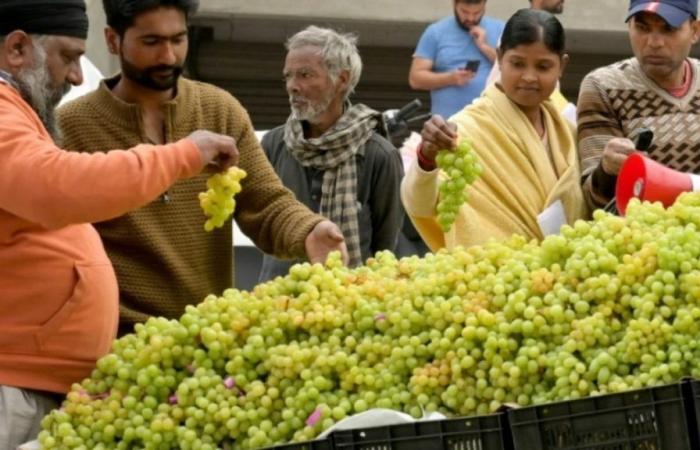Grape seller in the Indian city of Amritsar
Narinder NANU
World wine production, affected by different meteorological phenomena, fell by 10% in 2023, reaching a minimum since 1961, and consumption decreased by 3%, the international organization of the sector reported this Thursday (25).
Winegrowers around the world produced a total of 237 million hectoliters, the lowest harvest since 1961. According to the International Organization of Vine and Wine (OIV), harvests were particularly poor in Italy – where they declined by 23% compared to 2022 , standing at 38 million hectoliters – and in Spain, where there was a 21% drop, to 28 million hectoliters.
The drop in global production was a direct consequence of “extreme environmental conditions”, which included droughts or floods, heat waves or early frosts and fires, and affected both the northern and southern hemispheres, explained OIV director John Barker.
Thus, the harvest decreased by 11% in Chile and Australia and 10% in South Africa, the three largest producers in the southern hemisphere. Argentina recorded a 23% drop, reaching the lowest level since 1957, while in Brazil wine production increased by 12.1% compared to 2022 and 31.4% compared to the average of the last five years.
With harvests almost over, production in the southern hemisphere is expected to recover 5% in 2024, according to the OIV’s first estimates.
In France, the harvest grew by 4%, to 48 million hectoliters, making the country the largest producer.
– Drop in consumption –
Consumption fell by 3% last year to 221 million hectoliters, the lowest level since 1996. Spain was one of the few markets where this did not happen, and total consumption was 9.8 million hectoliters, 1. 7% more than in 2022.
In South America, consumption fell 6.2% in Argentina, to the lowest level in recent history, and increased 11.6% in Brazil, returning to 2020-2021 levels.
The downward trend has been ongoing since 2018 – except for the recovery in 2021 due to the lifting of restrictions linked to Covid-19 – and is due, in part, to inflation, which increased production costs and consumer prices.
The lower demand is also due to “demographic and lifestyle changes”, highlighted John Barker. The Portuguese, French and Italians are, per capita, the largest consumers.
Wine exports fell 6% in volume, reaching the lowest level since 2010. According to the OIV, the increase in the average export price may have deterred buyers.
– Smaller surface –
The area dedicated to vineyards, whether for the production of wine or table grapes, decreased for the third consecutive year by 0.5% in 2023, to 7.2 million hectares.
In Spain, the largest vineyard in the world, with 945 thousand hectares, the area decreased by 1%, as well as in Argentina (1.1%) and Chile (5.6%). Brazil increased its surface for the third consecutive year, to 83 thousand hectares, 1.5% more than in 2022.
In India, the area increased by 3%, and the country entered the list of the 10 largest vineyards in the world. Italy had the lowest production since 1950.
With the rains, which favored the emergence of the mildew fungus in the central and southern regions; hail and floods, the drop “was clearly related to meteorological conditions”, which is why it must be momentary, said Barker.
The problems that affected the vineyards this year are disparate and the influence of climate change was not evident in all cases. However, “the biggest current challenge for the sector is climate change, which seriously affects the vine, a perennial plant that is usually cultivated in areas vulnerable” to global warming, highlighted the director of the OIV.
read more
Tags: World wine production fell
--





